The first of two single day Late Autumn Tours today in North Norfolk. It was a cloudy and grey day, rather misty at times, but dry and fairly mild with only light winds. The light could have been better but the weather could have been a lot worse! We had a nice day out in the end.
Our first destination this morning was Holkham. As we got out of the minibus on Lady Anne’s Drive, there were lots of Wigeon whistling on the grazing marshes on either side. A few Greylags were out on the wet grass too and two Brent Geese flew over. A couple of Jays flew back and forth overhead, commuting back and forth looking for acorns.
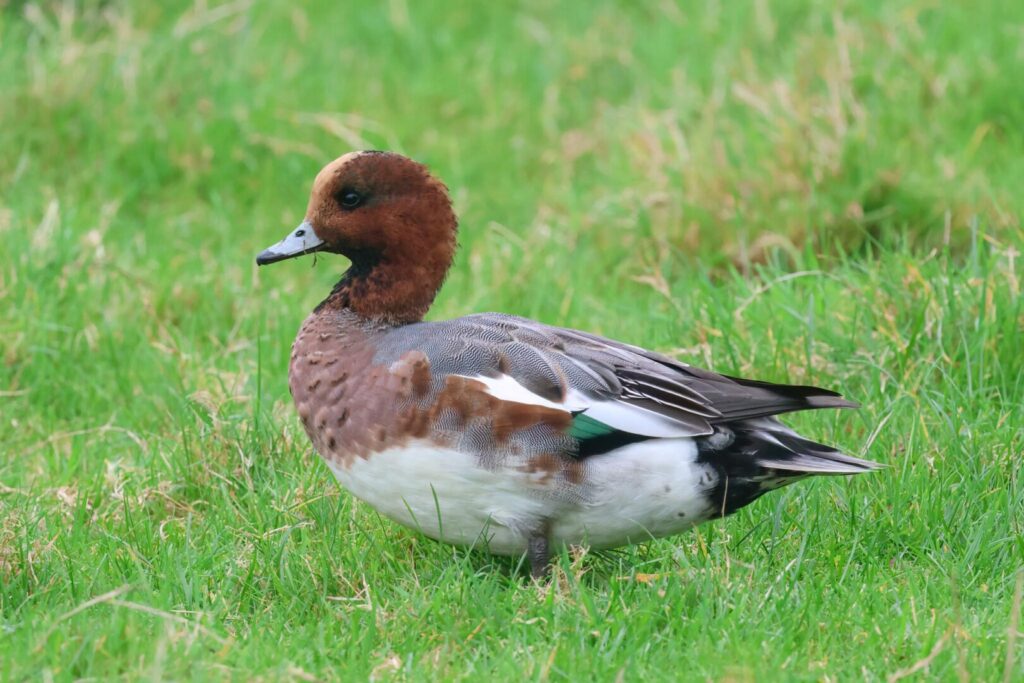
We made our way through the pines and out onto the edge of the saltmarsh beyond. A pair of Egyptian Geese were calling noisily in the trees and we could hear Pink-footed Geese now too. A small group of Blackbirds flew in over the pines and one landed briefly in the tops. Presumably migrants, freshly arrived from Scandinavia for the winter.
As we walked east along the edge of the saltmarsh, a small flock of Brent Geese was feeding out in the vegetation quite close to the path so we stopped for a look. Some more groups were still flying in over the pines and dropping down to join them. Several Skylark came overhead calling. A flock of Starlings flew through heading west, more migrants freshly arrived and making their way inland. The first of several groups of migrating Starlings we would see today.
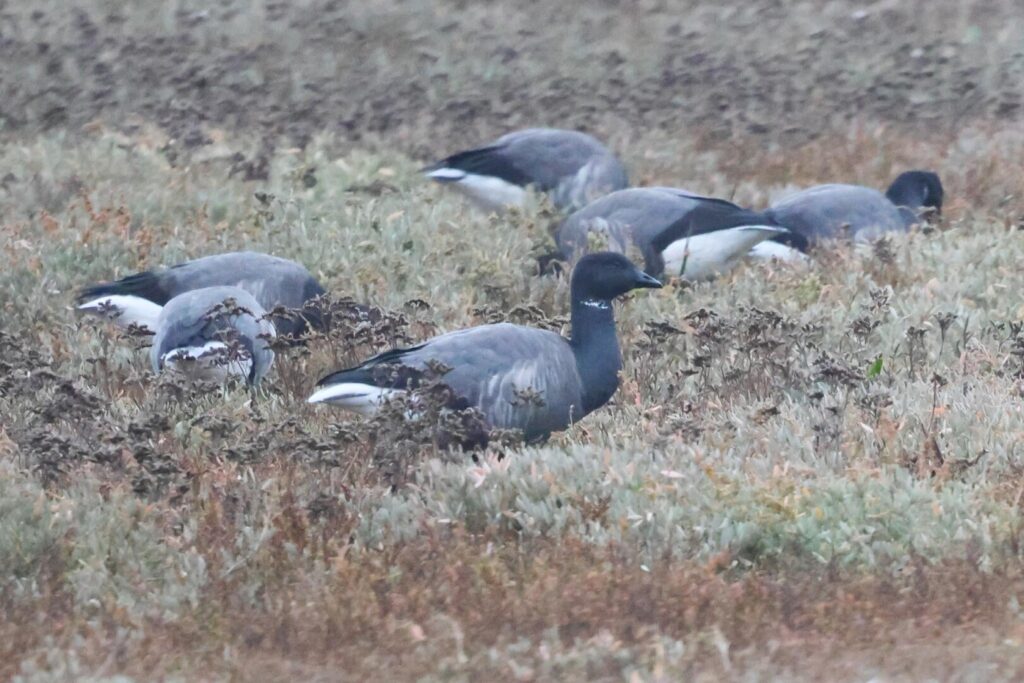
Down towards the cordon, we met someone walking back who told us that apparently there was no sign of the Shorelarks this morning. A bit disappointing. When we got to the corner of the rope we had a quick scan anyway and were surprised to see them out on the grass at the far end. We had a quick look, then walked further down for a closer view.
Good views through the scope now, we watched the Shorelarks as they fed in the short vegetation. At one point, the male appeared to be keeping watch, standing on a small mound, preening occasionally, before it resumed feeding. Then for no reason they took off, circled round over the cordon a couple of times, and then flew off east. They seemed to land somewhere out on the beach towards Wells. Good timing!
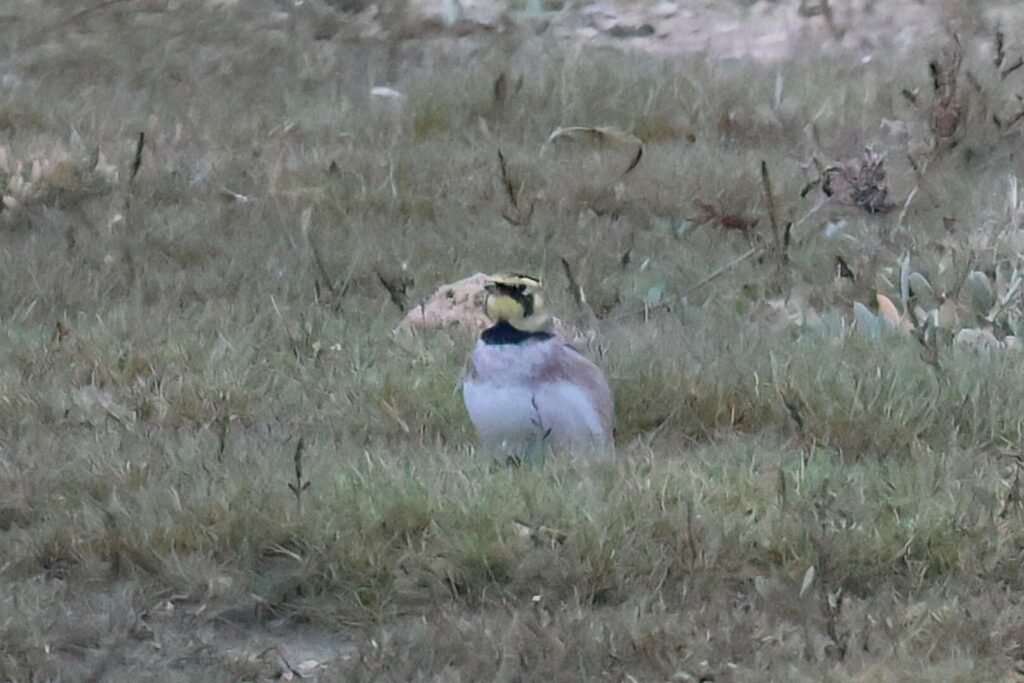
We made our way round the end of the cordon and out onto the beach. It was still rather misty offshore, but we could still see hundreds and hundreds of Common Scoters out on the sea. They were a bit too far out to see if there was anything else with them though. A few Sanderling were feeding on the edge of the water, running around like clockwork toys on the sand, and a juvenile Gannet flew past over the beach.
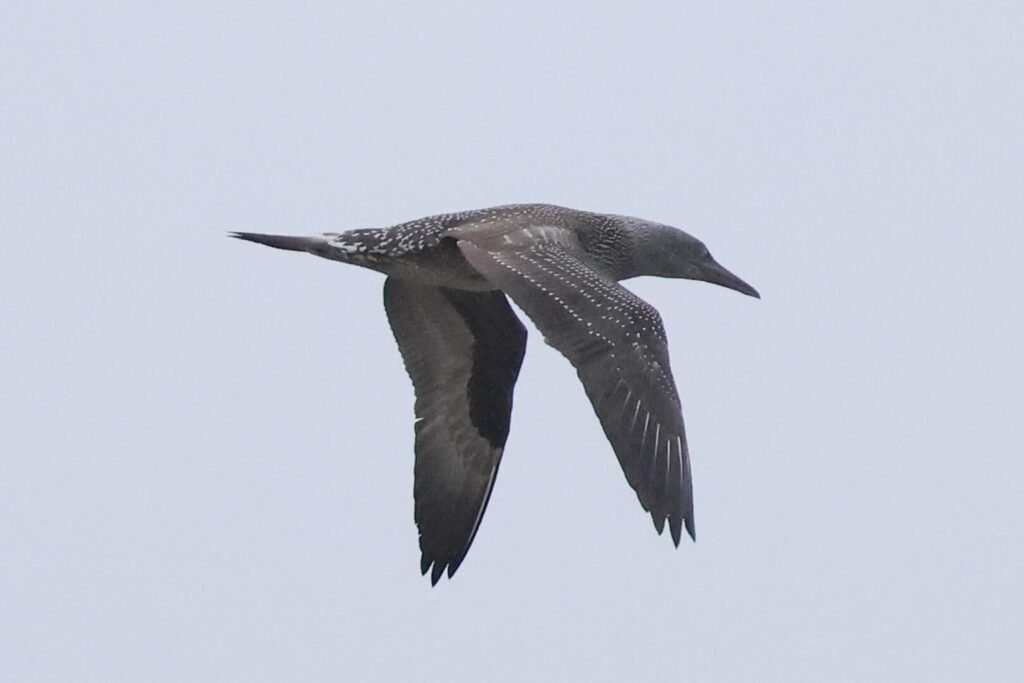
There had been a couple of Great Northern Divers offshore in recent days, and we could see them now some way off to the west. They were diving all the time and hard to see from here, so we walked further down the beach.
We hadn’t gone far when we noticed two Snow Buntings in the edge of dunes. As we walked closer, we lost sight of them. Scanning, we found one now feeding on the high tide line ahead of us. We got it in the scopes and had a better look, but it was picking its way away from us all the time. We thought we might be able to get past without disturbing it by walking out further onto the beach but before we could get round it flew back along the beach the way we had come.
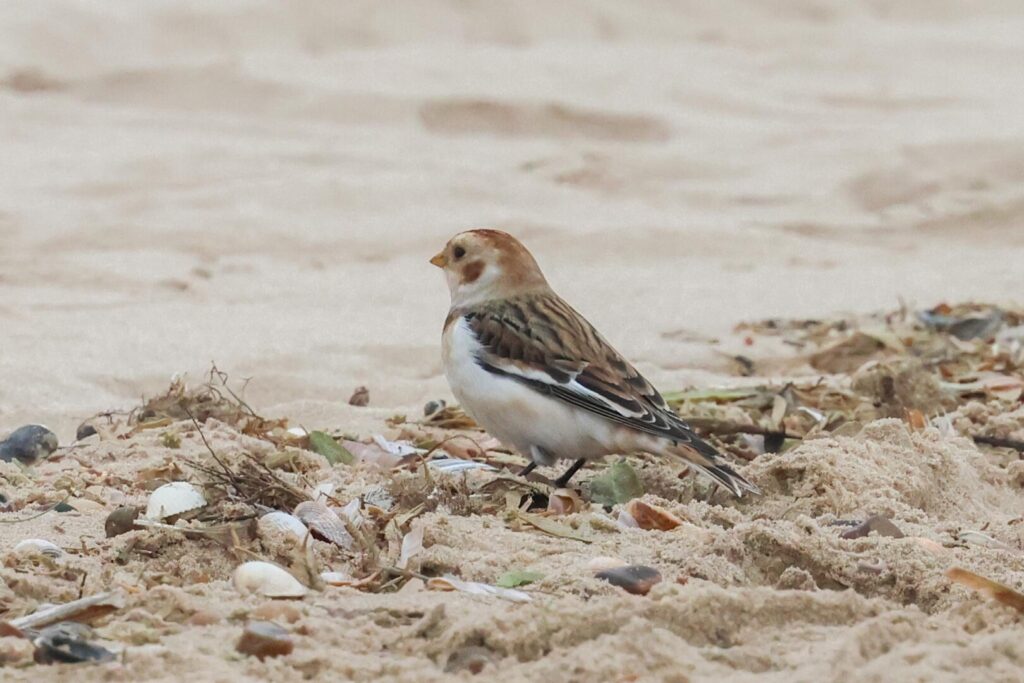
The two Great Northern Divers were now just offshore but they were still diving repeatedly and hard to see in the small swell. From up in the dunes, we had a better view. One of the Great Northern Divers was still in almost full breeding plumage, unusual to see here at this time of year and absolutely stunning. The second was already more advanced in its moult to paler non-breeding plumage.
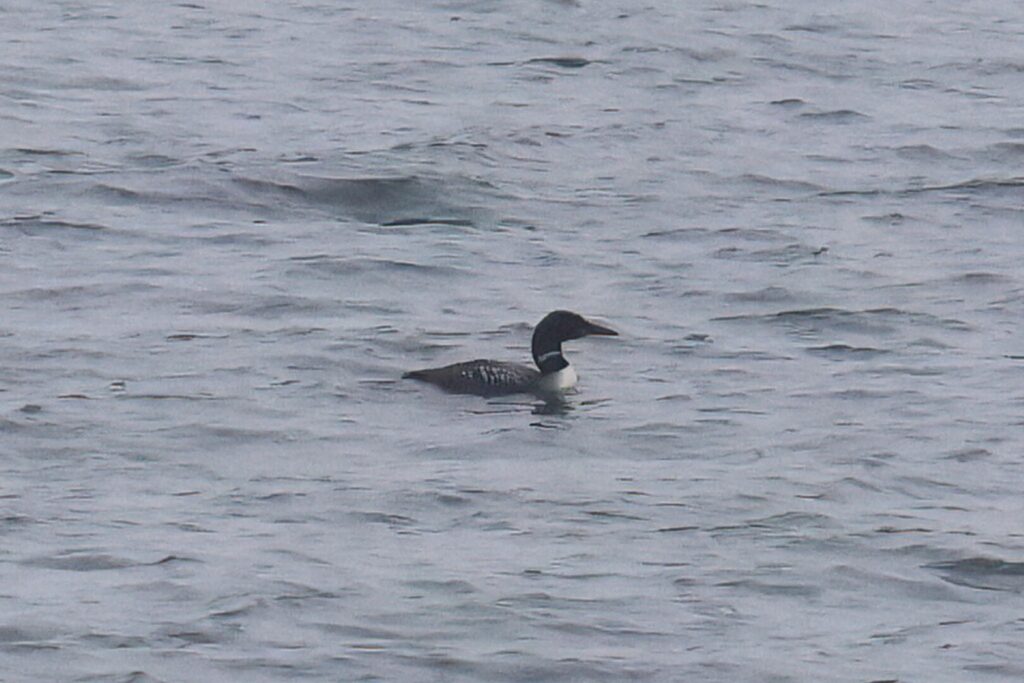
We couldn’t see anything else offshore, though the mist was still hampering our efforts. We decided to make our way back. A quick scan from the path and we could see that the Shorelarks had returned to the far end of the cordon. Two Rock Pipits flew over the saltmarsh, before dropping down into a channel out of view.
As we cut back through the pines, a tit flock passed quickly overhead but quickly disappeared into the trees the other side. We could head Pink-footed Geese calling and when we got back out of the trees we could see a small flock circling over the grazing meadows. When they dropped down and landed in the grass, we got them in the scopes. There were a couple of Greylags next to them for comparison. Two Canada Geese were feeding on one of the pools closer to the Drive.
Walking back to the minibus, a Pied Wagtail was posing on a fence post and several Meadow Pipits flew round over the grass beyond. A couple of Grey Herons were out with the cows. As we drove west, we spotted some Cattle Egrets with cows by the main road but couldn’t stop. There had been more recently by the road at Burnham Norton, where there are places to pull in, so we thought we could see them there instead. But when we got there, we couldn’t see any here today.
We diverted inland at Choseley. Driving up the hill, several Blackbirds flicked in and out of the hedges by the road. A large flock of Linnets came up from a weedy strip in the field beyond the hedge. A Kestrel perched up nicely right by the road, so we pulled up briefly to admire it.
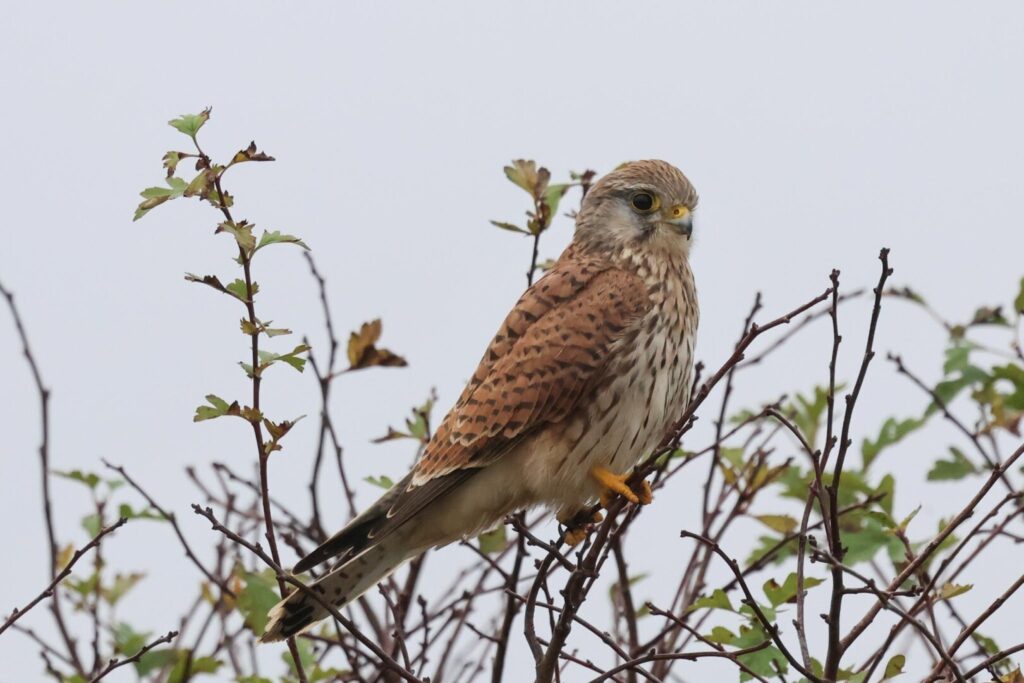
Further on, we stopped again and got out. We were disappointed to see that the recently harvested sugar beet field here had already been cultivated. The beet tops which the Pink-footed Geese like to feed on had been turned in and not left for them. A Pied Wagtail was climbing around on the stack of beet. A small flock of Golden Plovers came up over the field beyond, where a Chinese Water Deer appeared briefly from behind the hedge.
A Stoat ran away along the edge of the field opposite, occasionally stopping and looking round. There were lots of Red-legged Partridges on the edge of the maize strip further down, released for shooting and unaware of their impending fate. There were several Yellowhammers and Chaffinches in the hedges our side of the road, flying in and out of a nearby seed plot. A couple of Red Kites hung in the air over the field beyond.
As we drove back up the road, we flushed several Redwings from the hedges now. A Fieldfare flew back away across the edge of one of the fields, flashing its grey rump. It was time for lunch now, so we made our way down to Titchwell.
After lunch, we made our way round to the Visitor Centre to check in, then headed out along Fen Trail first. The resident Tawny Owl was well tucked in today and impossible to see – there are still too mane leaves on the trees. A Chiffchaff was calling in the sallows just beyond but we couldn’t see it.
Round at Patsy’s, the Bittern had apparently been seen earlier but there was no sign of it now. We didn’t know whether it was still lurking in the reeds out of sight somewhere or it had flown off , so we figured it wasn’t worth lingering too long. There were a few Gadwall and Coot out on the water. A few Common Gulls dropped in with the Black-headed Gulls to bathe. Several Chaffinches flew over and we heard a Brambling call but couldn’t see it.
One Marsh Harrier was perched in a distant dead tree and another flew round over the reedbed. A third then came across over the water much closer in front of us.
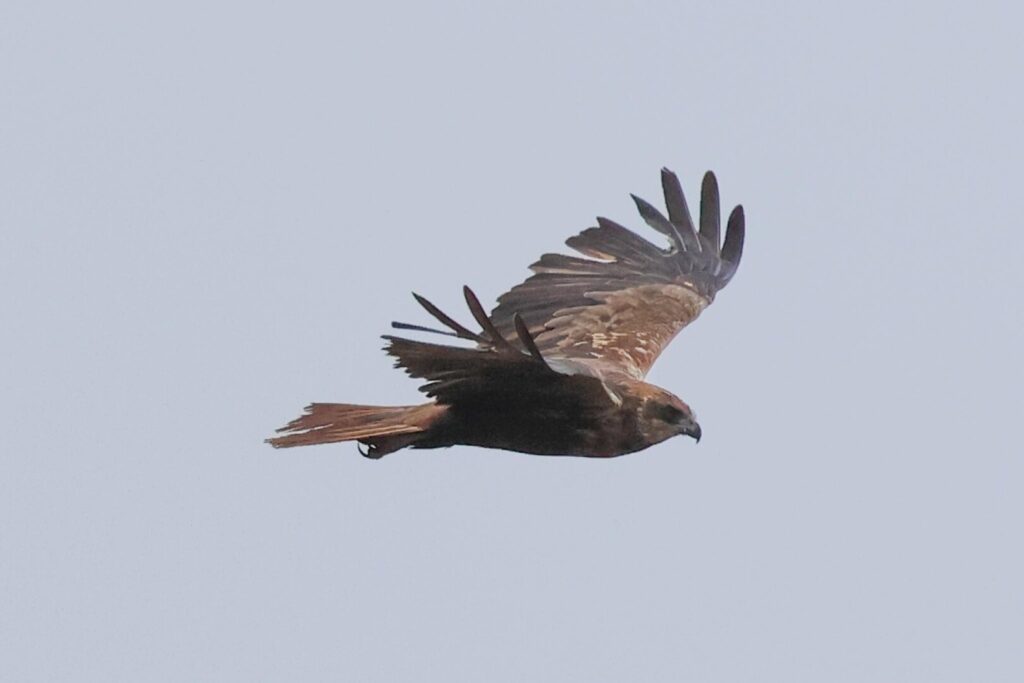
We made our way back round via Meadow Trail to the main path. There were tits in the trees here now, including several Long-tailed Tits, and we managed to catch up with a Chiffchaff now briefly in the sallows.
Out on the Reedbed Pool, there were a few more Gadwall and a couple of juvenile Mute Swans. A single female Tufted Duck was at the back. One of the Marsh Harriers was still in the trees at the back of the reedbed, but the reeds themselves were quiet today. The small birds were keeping their heads down in the cool and misty weather.
Scanning the Freshmarsh from the path by Island Hide, we could see four Spoonbills over on the far compartment, so we got them in the scopes. One flew out and low overhead. Small flocks of Brent Geese flew in and out. Further up we stopped again to scan by the bund. There was a nice selection of ducks on the water, most looking smart now getting back into breeding plumage. A single drake Pintail was upending out in the water, still to get its long pin tail back. More Pintail were asleep or preening on one of the islands.
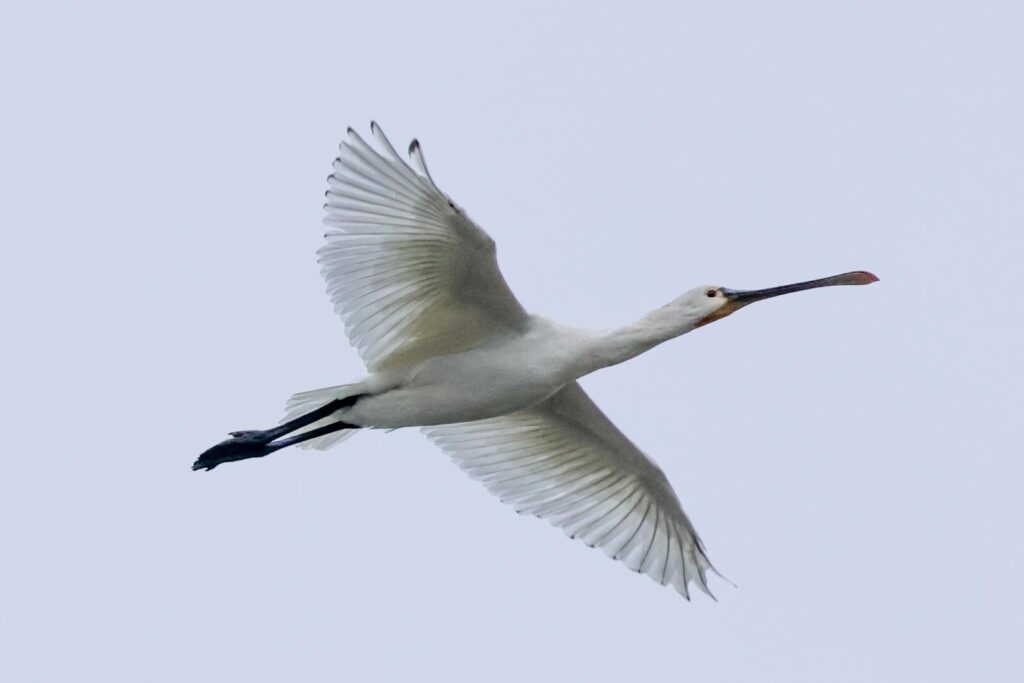
The large flock of Golden Plover was loafing out in the shallow water today rather than on the bund. Easier to see here. Several Dunlin and a single Turnstone were picking around on the edge of the islands nearby, along with a couple of Ruff and a single Black-tailed Godwit. A Common Snipe flew up and over the path, disappearing down towards the saltmarsh beyond. There was no sign of escaped Black-winged Stilt which has taken up residence here, but we did find two lingering Avocets over at the back.
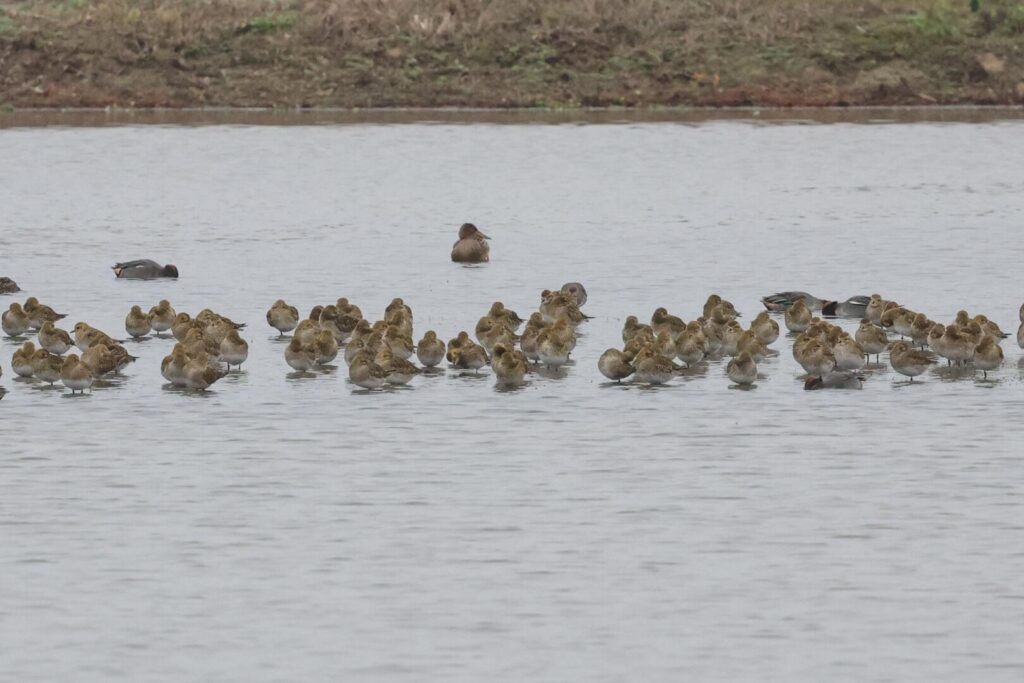
The Spoonbills were flying in and out now over the path. One dropped down onto the saltmarsh just the other side of the bank where we had a good view of it, an adult with a yellow-tip to its black bill. It had a disagreement with a nearby Little Egret.
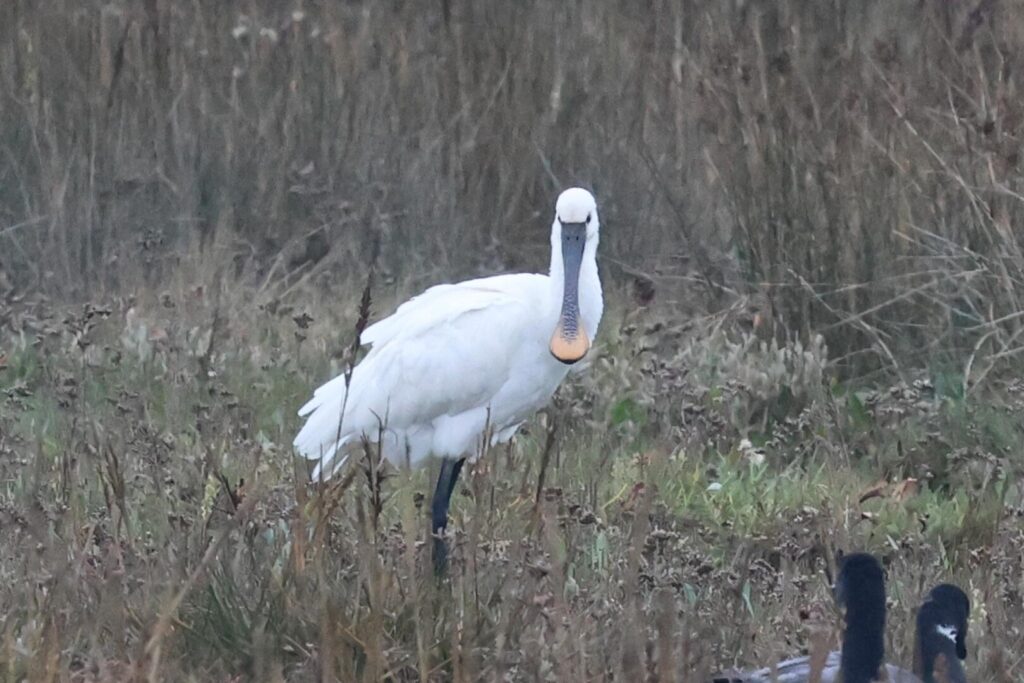
We decided to walk straight on to the beach. A Curlew was preening on a small mound in the channel on the Volunteer Marsh. Further up, a Redshank was picking around on the mud close to the path, and a couple of Little Egrets were squabbling over who was going to feed here. We could see the yellow feet on one as it flew off past us.
There were more waders on the Tidal Pool. Scanning the sandy islands at the back, at one point we had Grey Plover, Dunlin, Turnstone, Curlew, Redshank and Bar-tailed Godwit all in the same view. A close Black-tailed Godwit was wading in the water up to its belly, with more further back. We could see a couple of Ringed Plovers too. Several Little Grebes were diving out on the water.
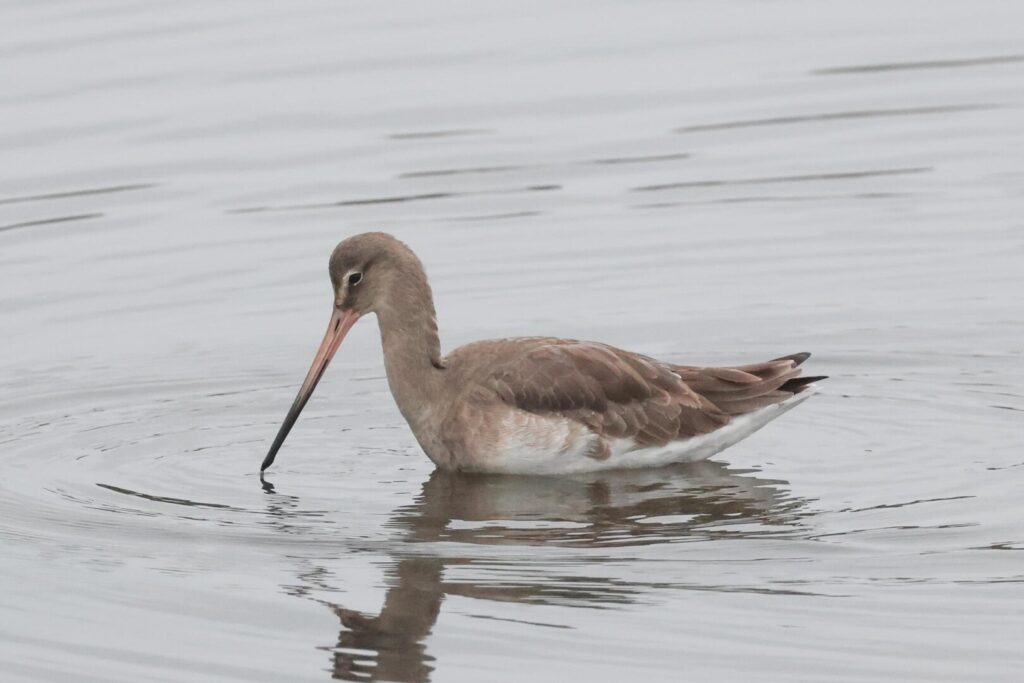
Someone further up shouted to say that there was a Kingfisher. We couldn’t see it from where we were, so we walked up further. It was hiding in the Suaeda but we saw it as it flew out and splashed into the water a couple of times. Then it disappeared back in, presumably to preen after its bath. A Song Thrush flew in over the water, presumably another freshly arrived migrant.
Apparently the Black-winged Stilt had been on the Tidal Pool earlier and then moved out onto the saltmarsh, but despite scanning we couldn’t find any sign of it either side now. A Stonechat was out on the bushes.
Out at the beach, we quickly got the scope onto the two Slavonian Grebes which were offshore to the west. They were going away and diving all the time, but we managed to get a good look at them before they got too far away. We could see several Great Crested Grebes too, and three Goldeneye. A couple were walking their spaniel on the beach, off the lead. It was racing around, chasing after all the gulls and waders. The owners seemed to have no interest in calling it back. Not surprisingly, everything flushed.
Turning our attention back to the sea, a Red-throated Diver was diving right in the breakers. It looked too shallow, like it might bang its head on the bottom! The biggest surprise out here was a Mute Swan out on the sea in the distance. Slowly it swam its way closer inshore. Perhaps an exhausted migrant, taking a rest after flying most of the way from the Continent.
Gradually the waders started to filter back. Lots of Oystercatchers, a few Sanderling. We had nice view of a Bar-tailed Godwit out on the sand now. One last scan of the sea before we walked back, and we spotted a Black-necked Grebe offshore now. A nice last minute bonus! We could see the different shape of its head compared to the Slavonian Grebes we had seen earlier, and the darker sides to the face too.
As we passed, we had another quick scan of the saltmarsh and Tidal Pool but there was still no sign of the Black-winged Stilt. Back at the Freshmarsh, we found out why – it was back here! The light was going, but we had a nice look at it in the scope. We still don’t know where it has come from, but a smart bird to see nonetheless.
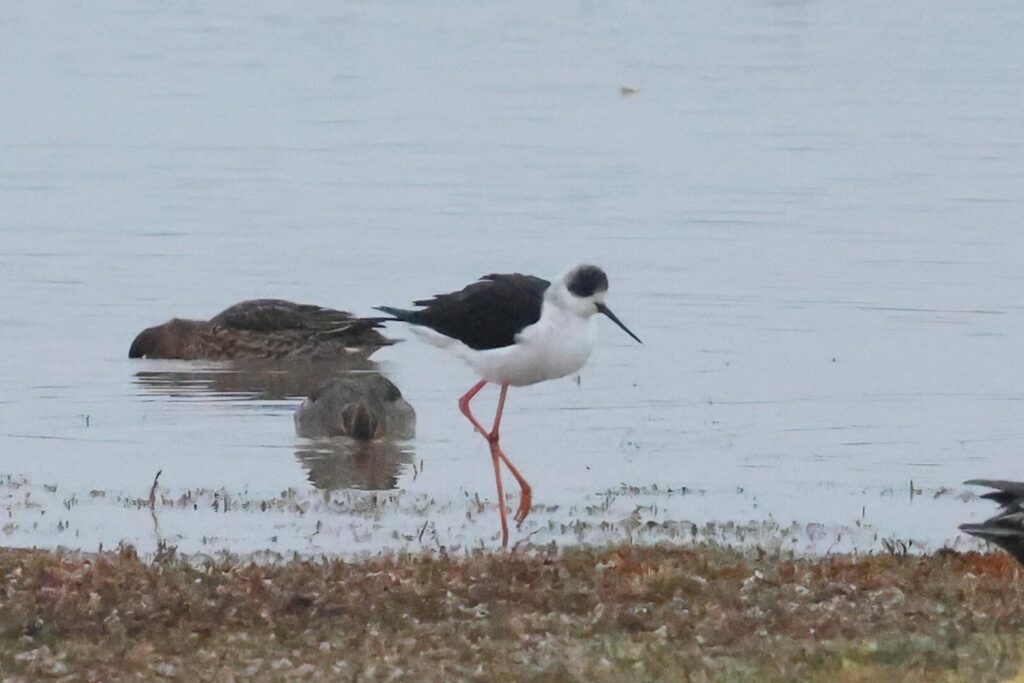
Lots of gulls were dropping in to bathe and roost, Herring Gulls and Lesser Black-backed Gulls. We had a quick look through but couldn’t see anything else with them this evening. A Cetti’s Warbler was calling from the reeds below us, and we caught a flash as two chased across briefly.
There was not much Marsh Harrier activity tonight, possibly it was a bit too still for them. Several were already in the reedbed, perched in the bushes. Three more were circling out over the reeds towards Thornham and as we walked past, two drifted in overhead to roost. A small flock of Starlings shot in low over the path towards the reedbed, almost taking our heads off in the process. A Water Rail was calling.
The light was going fast – it happens at this time of year but it didn’t help that it was still misty too. Time to head back. It had been a good Late Autumn day out.
If you like what you read, you would be welcome to join one of tours – you can see what we have planned on our Tours page here.
















